Learninsta presents the core concepts of Biology with high-quality research papers and topical review articles.
Sensory Reception and Processing
Our senses make us aware of changes that occur in our surroundings and also within our body. Sensation [awareness of the stimulus] and perception [interpretation of the meaning of the stimulus] occur in the brain.
Receptors are Classified Based on Their Location:
1. Exteroceptors are located at or near the surface of the body. These are sensitive to external stimuli and receive sensory inputs for hearing, vision, touch, taste and smell.
2. Interoceptors are located in the visceral organs and blood vessels. They are sensitive to internal stimuli. Proprioceptors are also a kind of interoceptors. They provide information about position and movements of the body.
These are located in the skeletal muscles, tendons, joints, ligaments and in connective tissue coverings of bones and muscles. Receptors based on the type of stimulus are shown in Table 10.3.

Photoreceptor – Eye
Eye is the organ of vision; located in the orbit of the skull and held in its position with the help of six extrinsic muscles. They are superior, inferior, lateral, median rectus muscles, superior oblique and inferior oblique muscles. These muscles aid in the movement of the eyes and they receive their nerve innervation from III, IV and VI cranial nerves.
Eyelids, eye lashes and eye brows are the accessory structures useful in protecting the eyes. The eye lids protect the eyes from excessive light and foreign objects and spread lubricating secretions over the eyeballs.
Eyelashes and the eyebrows help to protect the eyeballs from foreign objects, perspiration and also from the direct rays of sunlight. Sebaceous glands at the base of the eyelashes are called ciliary glands which secrete a lubricating fluid into the hair follicles.
Lacrymal glands, located in the upper lateral region of each orbit, secrete tears. Tears are secreted at the rate of 1mL/day and it contains salts, mucus and lysozyme enzyme to destroy bacteria. The conjunctiva is a thin, protective mucous membrane found lining the outer surface of the eyeball (Figure 10.13).
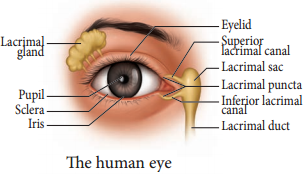
The eye has two compartments, the anterior and posterior compartments. The anterior compartment has two chambers, first one lies between the cornea and iris and the second one lies between the iris and lens. These two chambers are filled with watery fluid called aqueous humor.
The posterior compartment lies between the lens and retina and it is filled with a jelly like fluid called vitreous humor that helps to retain the spherical nature of the eye. Eye lens is transparent and biconvex, made up of long columnar epithelial cells called lens fires. These cells are accumulated with the proteins called crystalline.
The Eye Ball
The eye ball is spherical in nature. The anterior one – sixth of the eyeball is exposed; the remaining region is fitted well into the orbit. The wall of the eye ball consists of three layers: firous Sclera, vascular Choroid and sensory Retina (Figure 10.14).
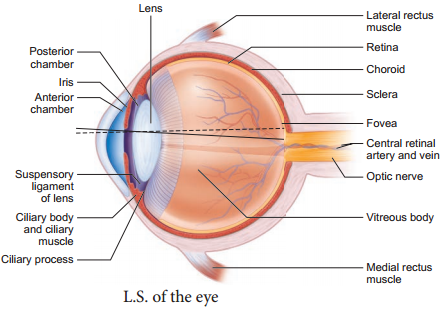
The outer coat is composed of dense non-vascular connective tissue. It has two regions: the anterior cornea and the posterior sclera. Cornea is a non-vascular transparent coat formed of stratified squamous epithelium which helps the cornea to renew continuously as it is very vulnerable to damage from dust. Sclera forms the white of the eye and protects the eyeball.
Posteriorly the sclera is innervated by the optic nerve. At the junction of the sclera and the cornea, is a channel called ‘canal of schlemm’ which continuously drains out the excess of aqueous humor.
Choroid
Is highly vascularized pigmented layer that nourishes all the eye layers and its pigments absorb light to prevent internal reflection. Anteriorly the choroid thickens to form the ciliary body and iris. Iris is the coloured portion of the eye lying between the cornea and lens. The aperture at the centre of the iris is the pupil through which the light enters the inner chamber.
Iris is made of two types of muscles the dilator papillae (the radial muscle) and the sphincter papillae (the circular muscle). In the bright light, the circular muscle in the iris contract; so that the size of pupil decreases and less light enters the eye.
In dim light, the radial muscle in the iris contract; so that the pupil size increases and more light enters the eye. Smooth muscle present in the ciliary body is called the ciliary muscle which alters the convexity of the lens for near and far vision.
The ability of the eyes to focus objects at varying distances is called accommodation which is achieved by suspensory ligament, ciliary muscle and ciliary body. The suspensory ligament extends from the ciliary body and helps to hold the lens in its upright position. The ciliary body is provided with blood capillaries that secrete a watery fluid called aqueous humor that fills the anterior chamber.
Retina Forms the Inner Most Layer of the Eye and it Contains Two Regions:
A sheet of pigmented epithelium (non visual part) and neural visual regions. The neural retina layer contains three types of cells: photoreceptor cells – cones and rods (Figure 10.15 and Table 10.4), bipolar cells and ganglion cells.
The yellow flat spot at the centre of the posterior region of the retina is called macula lutea which is responsible for sharp detailed vision. A small depression present in the centre of the yellow spot is called fovea centralis which contains only cones.
The optic nerves and the retinal blood vessels enter the eye slightly below the posterior pole, which is devoid of photo receptors; hence this region is called blind spot.
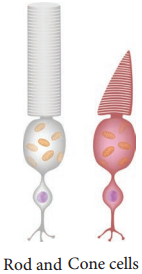
Differences between rod and cone cells

Mechanism of Vision
When light enters the eyes, it gets refracted by the cornea, aqueous humor and lens and it is focused on the retina and excites the rod and cone cells. The photo pigment consists of Opsin, the protein part and Retinal, a derivative of vitamin A.
Light induces dissociation of retinal from opsin and causes the structural changes in opsin. This generates an action potential in the photoreceptor cells and is transmitted by the optic nerves to the visual cortex of the brain, via bipolar cells, ganglia and optic nerves, for the perception of vision.
Refractive Errors of Eye
Myopia (near sightedness):
The affected person can see the nearby objects but not the distant objects. This condition may result due to an elongated eyeball or thickened lens; so that the image of distant object is formed in front of the yellow spot. This error can be corrected using concave lens that diverge the entering light rays and focuses it on the retina.
Hypermetropia (Long Sightedness):
The affected person can see only the distant objects clearly but not the objects nearby. This condition results due to a shortened eyeball and thin lens; so the image of closest object is converged behind the retina. This defect can be overcome by using convex lens that converge the entering light rays on the retina.
Presbyopia:
Due to aging, the lens loses elasticity and the power of accommodation. Convex lenses are used to correct this defect.
Astigmatism
Is due to the rough (irregular) curvature of cornea or lens. Cylindrical glasses are used to correct this error (Figure 10.16).
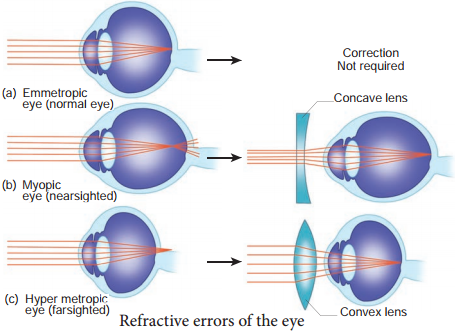
Cataract:
Due to the changes in nature of protein, the lens becomes opaque. It can be corrected by surgical procedures.
Phonoreceptor
The ear is the site of reception of two senses namely hearing and equilibrium. Anatomically, the ear is divided into three regions: the external ear, the middle ear and internal ear.
The external ear consists of pinna, external auditory meatus and ear drum. The pinna is flap of elastic cartilage covered by skin. It collects the sound waves. The external auditory meatus is a curved tube that extends up to the tympanic membrane [the ear drum]. The tympanic membrane is composed of connective tissues covered with skin outside and with mucus membrane inside.
There are very fine hairs and wax producing sebaceous glands called ceruminous glands in the external auditory meatus. The combination of hair and the ear wax [cerumen] helps in preventing dust and foreign particles from entering the ear.
The middle ear is a small air-filled cavity in the temporal bone. It is separated from the external ear by the eardrum and from the internal ear by a thin bony partition; the bony partition contains two small membrane covered openings called the oval window and the round window.
The Middle Ear Contains Three Ossicles:
Malleus [hammer bone], incus [anvil bone] and stapes [stirrup bone] which are attached to one another. The malleus is attached to the tympanic membrane and its head articulates with the incus which is the intermediate bone lying between the malleus and stapes.
The stapes is attached to the oval window in the inner ear. The ear ossicles transmit sound waves to the inner ear. A tube called Eustachian tube connects the middle ear cavity with the pharynx. This tube helps in equalizing the pressure of air on either sides of the ear drum.
Inner ear is the fluid filled cavity consisting of two parts, the bony labyrinth and the membranous labyrinths. The bony labyrinth consists of three areas: cochlea, vestibule and semicircular canals. The cochlea is a coiled portion consisting of 3 chambers namely: scala vestibuli and scala tympani – these two are filled with perilymph; and the scala media is filled with endolymph.
At the base of the cochlea, the scala vestibule ends at the ‘oval window’ whereas the scala tympani ends at the ‘round window’ of the middle ear. The chambers scala vestibuli and scala media are separated by a membrane called Reisner’s membrane whereas the scala media and scala tympani are separated by a membrane called Basilar membrane (Figure 10.17)
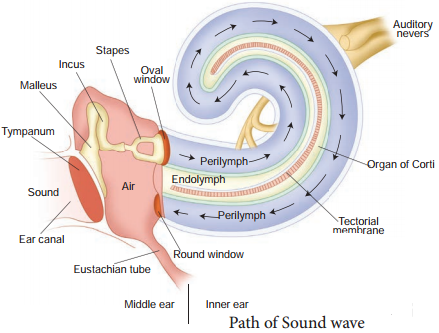
Organ of Corti
The organ of Corti (Figure.10.18) is a sensory ridge located on the top of the Basilar membrane and it contains numerous hair cells that are arranged in four rows along the length of the basilar membrane. Protruding from the apical part of each hair cell is hair like structures known as stereocilia. During the conduction of sound wave, stereocilia makes a contact with the stiff gel membrane called tectorial membrane, a roof like structure overhanging the organ of corti throughout its length.
Mechanism of Hearing
Sound waves entering the external auditory meatus fall on the tympanic membrane. This causes the ear drum to vibrate, and these vibrations are transmitted to the oval window through the three auditory ossicles. Since the tympanic membrane is 17-20 times larger than the oval window, the pressure exerted on the oval window is about 20 times more than that on the tympanic membrane.
This increased pressure generates pressure waves in the fluid of perilymph. This pressure causes the round window to alternately bulge outward and inward meanwhile the basilar membrane along with the organ of Corti move up and down.
These movements of the hair alternately open and close the mechanically gated ion channels in the base of hair cells and the action potential is propagated to the brain as sound sensation through cochlear nerve.
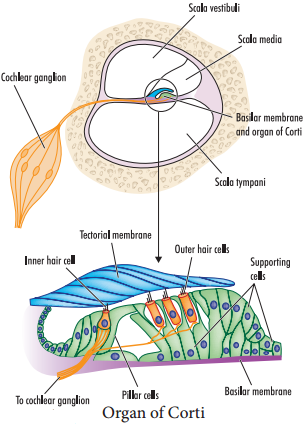
Defects of Ear
Deafness may be temporary or permanent. It can be further classified into conductive deafness and sensory-neural deafness. Possible causes for conductive deafness may be due to
- The blockage of ear canal with earwax
- Rupture of eardrum
- Middle ear infection with fluid accumulation
- Restriction of ossicular movement. In sensory-neural deafness, the defect may be in the organ of Corti or the auditory nerve or in the ascending auditory pathways or auditory cortex.
Organ of Equilibrium
Balance is part of a sense called proprioception, which is the ability to sense the position, orientation and movement of the body. The organ of balance is known as the vestibular system which is located in the inner ear next to the cochlea. The vestibular system is composed of a series of fluid filled sacs and tubules.
These sacs and tubules contain endolymph and are kept in the surrounding perilymph (Figure 10.19). These two fluids, perilymph and endolymph, respond to the mechanical forces, during changes occurring in body position and acceleration.
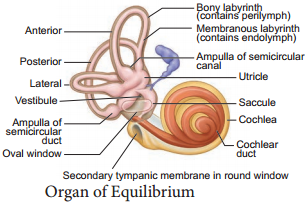
The utricle and saccule are two membranous sacs, found nearest the cochlea and contain equilibrium receptor regions called maculae that are involved in detecting the linear movement of the head. The maculae contain the hair cells that act as mechanorecptors.
These hair cells are embeded in a gelatinous otolithic membrane that contains small calcareous particles called otoliths. This membrane adds weight to the top of the hair cells and increase the inertia.
The canals that lie posterior and lateral to the vestibule are semicircular canals; they are anterior, posterior and lateral canals oriented at right angles to each other. At one end of each semicircular canal, at its lower end has a swollen area called ampulla. Each ampulla has a sensory area known as crista ampullaris which is formed of sensory hair cells and supporting cells. The function of these canals is to detect rotational movement of the head.
Oldfactory Receptors
The receptors for taste and smell are the chemoreceptors. The smell receptors are excited by air borne chemicals that dissolve in fluids. The yellow coloured patches of oldfactory epithelium form the oldfactory organs that are located on the roof of the nasal cavity.
The oldfactory epithelium is covered by a thin coat of mucus layer below and oldfactory glands bounded connective tissues, above. It contains three types of cells: supporting cells, Basal cells and millions of pin shaped oldfactory receptor cells (which are unusual bipolar cells).
The oldfactory glands and the supporting cells secrete the mucus. The unmyelinated axons of the oldfactory receptor cells are gathered to form the filaments of oldfactory nerve [cranial nerve I] which synapse with cells of oldfactory bulb. The impulse, through the oldfactory nerves, is transmitted to the frontal lobe of the brain for identification of smell and the limbic system for the emotional responses to odour.
Gustatory Receptor:
The sense of taste is considered to be the most pleasurable of all senses. The tongue is provided with many small projections called papillae which give the tongue an abrasive feel. Taste buds are located mainly on the papillae which are scattered over the entire tongue surface.
Most taste buds are seen on the tongue (Figure 10.20) few are scattered on the sof palate, inner surface of the cheeks, pharynx and epiglottis of the larynx. Taste buds are flask-shaped and consist of 50 – 100 epithelial cells of two major types.
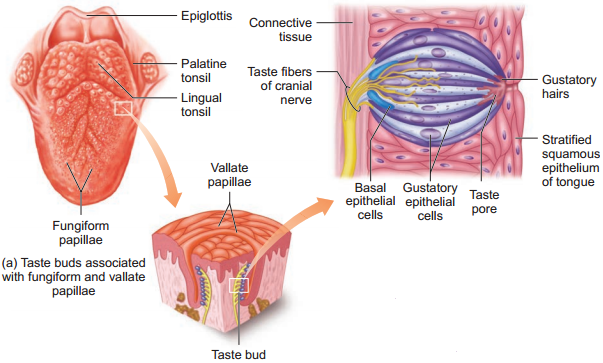
Gustatory epithelial cells (taste cells) and Basal epithelial cells (Repairing cells) Long microvilli called gustatory hairs project from the tip of the gustatory cells and extends through a taste pore to the surface of the epithelium where they are bathed by saliva.
Gustatory hairs are the sensitive portion of the gustatory cells and they have sensory dendrites which send the signal to the brain. The basal cells that act as stem cells, divide and differentiate into new gustatory cells (Figure 10.20).
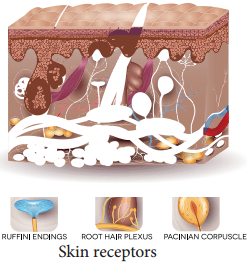
Skin-Sense of Touch
Skin is the sensory organ of touch and is also the largest sense organ. This sensation comes from millions of microscopic sensory receptors located all over the skin and associated with the general sensations of contact, pressure, heat, cold and pain.
Some parts of the body, such as the finger tips have a large number of these receptors, making them more sensitive. Some of the sensory receptors present in the skin (Figure 10.21) are:
Tactile Merkel Disc
Is light touch receptor lying in the deeper layer of epidermis.
Hair Follicle Receptors
Are light touch receptors lying around the hair follicles.
Meissner’s Corpuscles
Are small light pressure receptors found just beneath the epidermis in the dermal papillae. They are numerous in hairless skin areas such as finger tips and soles of the feet.
Pacinian Corpuscles
Are the large egg shaped receptors found scattered deep in the dermis and monitoring vibration due to pressure. It allows to detect different textures, temperature, hardness and pain.
Ruffi Endings
Which lie in the dermis responds to continuous pressure.
Krause End Bulbs
Are thermoreceptors that sense temperature.